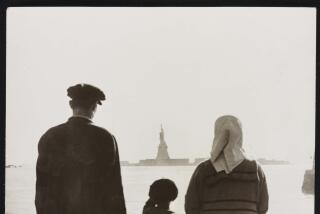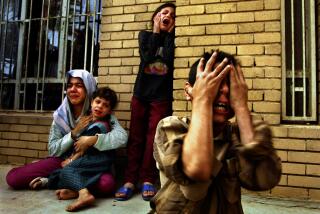An ugly American tradition that dates back to our earliest settlers: ‘Civilizing Torture’
George W. Bush’s bold 2007 proclamation that “This government does not torture people,” would have certainly come as news to Abdal Rahim al-Nashiri, an Al Qaeda operative who was tortured under the supervision of current CIA director Gina Haspel: al-Nashiri was repeatedly slammed against a wall, confined to a small box, waterboarded, deprived of sleep and food, and subjected to various threats and humiliations.
The idea that torture is somehow anathema to America would also come as a surprise to the wife of Bill Owens of North Carolina: In 1864, Owens, a Unionist guerilla leader, disappeared, and Confederate soldiers tied his wife’s hands behind her back and then lifted her off the ground by her thumbs to get her to divulge his whereabouts — when she didn’t talk, they smashed her thumbs between two rail posts.
Roosevelt Scott would likewise take issue with Bush’s vision of a torture-free America: Scott, a black Chicagoan, was arrested on suspicion of murder in 1959. Over a 24-hour period, Scott was hit by police interrogators with a baseball bat, a blackjack and a city phone directory; he was also stripped naked and forced to lie on the floor while police struck his testicles with a belt.
W. Fitzhugh Brundage’s “Civilizing Torture: An American Tradition,” offers a sobering history of how American communities and institutions have relied on torture in various forms since before the United States was founded. From indigenous American cultures’ use of ritualized torture to the techniques imported from Europe by early European settlers, to the various acts of cruelty and violence employed by prison guards, slave owners, the police and American soldiers, Brundage makes the (in retrospect obvious) case that torture is a fundamental part of America’s history and makeup. “Torture in the United States has been in plain sight,” Brundage writes, “at least for those who have looked for it.” And indeed, the main purpose of “Civilizing Torture” is to understand why most of us have chosen not to look for it.
Brundage goes back to 1528 and some of the earliest encounters between indigenous Americans and European settlers: Both cultures regularly used torture, of course, but for each society torture was ritualized through a set of complex but well-articulated religious and legal techniques. Among the Huron and the Iroquois, for example, torture was used as a means to strip captives of their previous identities, so as to facilitate their assimilation into a new clan. Europeans, meanwhile, used torture as part of a legal strategy to coerce confession. Neither group had much interest or incentive in understanding these differing social structures, so it became an easy and expeditious shorthand among Anglo settlers to refer to Native American communities as “savage barbarians” who engaged in torture, as opposed to their own “civilized” European culture. But being civilized hardly stopped Salem’s Puritans from stacking rocks on Giles Corey’s body to elicit a plea of guilty or innocent to the charge that he was a witch. As the weight increased and Corey refused to plead, the punishment ultimately killed him, but this was not torture; this was law.
The law, of course, is what determines what is and isn’t torture. In 1857, the North Carolina Supreme Court coined the term “petit treason” to describe any act of self-defense by enslaved Americans who’d been attacked or abused by their owners, which in turn would offer legal protection for all manner of torture against those who tried to defend themselves. By putting people like those enslaved Americans outside the protection of the law, courts have routinely legitimized and justified torture, all while maintaining the fiction that we are a nation of laws.
The Civil War finally freed the slaves but in turn led to a bonanza of further war crimes and savage acts of torture by both the South and the North — most notoriously at the Confederate prison camp at Andersonville in Georgia, where Union POWs lived in holes they’d scraped out of the earth themselves, without enough food, in squalid conditions, trying not to be shot by guards; of the 45,000 to pass through the camp, 13,000 died. A rallying cry during the war, Andersonville’s atrocities were subsequently more or less forgotten by a nation trying to heal. “Apparently unable to reconcile the violence of the conflict with American innocence,” argues Brundage, “Americans instead practiced selective amnesia and consigned wartime torture and atrocities to the silence of the past.”
This refusal to look starkly at the face of torture in the American military was folly, as the atrocities at the village of My Lai 110 years later would show. The Vietnam War would reveal not only how little we had progressed as a nation, but also that the military chain of command seemed designed to allow everyone at every level to abdicate responsibility. Days after Lt. William Calley was convicted of murder for his role in My Lai, Reinhold Niebuhr commented: “This is the moment of truth when we realize we are not a virtuous nation.”
Brundage’s book does more than just affirm Niebuhr’s statement; it answers how we deceive ourselves into thinking we are a virtuous nation. Defining both “civilization” and “barbarism” is fundamentally a linguistic question, in which terms and definitions are massaged to fit an innate belief that “we” are civilized and “they” are barbarians. The use of the word “torture” is part and parcel of this operation: Torture, Brundage makes clear, is less a neutral term describing a set of violent actions than it is a fluid and adaptable recrimination used to label someone else’s violent actions, which by contrast then elevate our own society and its violent actions into the realm of the “civilized.”
Brundage’s title may seem broad, but it is exceedingly specific: The process by which torture is rendered invisible by euphemism and erasure, bolstering a myth that this country is “civilized,” is an enduring American tradition. The work of American torture has always been twofold: not just the violence itself, but the complex legal and rhetorical strategies that obfuscate it away to maintain a myth of America as a civilized place without cruel and unusual punishment.
In the case of Bush’s War on Terror, it’s clear now that there were two separate, parallel wars: one that involved violence done to actual physical bodies, and one that happened on a linguistic level. The euphemisms “enhanced interrogation” and “enemy combatant” did far more harm than any specific torture technique employed by the Bush administration, since they, like the North Carolina Supreme Court’s decision over a century earlier, put some human beings outside the reach of fundamental human rights laws, giving torturers carte blanche to do whatever they wanted.
For those who remember the Bush wars, the enhanced interrogation section of “Civilizing Torture,” will feel familiar, but Brundage’s point is to contextualize the self-serving arguments around enhanced interrogation into a longer history of colonial, settler, military and police torture. Abu Ghraib was by no means an outlier.
The mistake, Brundage suggests, is in thinking that simply calling one’s community or state “civilized” means that its inhabitants will intrinsically reject torture. In fact, it seems to be the opposite: Once a group embraces the idea that it is civilized, it will set to work devising linguistic euphemisms and developing historical amnesia — all to ignore the very real history of torture in its midst.
Dickey’s most recent book is “Ghostland: An American History in Haunted Places.”
“Civilizing Torture: An American Tradition”
W. Fitzhugh Brundage
Belknap Press: 416 pp., $35
More to Read
Sign up for our Book Club newsletter
Get the latest news, events and more from the Los Angeles Times Book Club, and help us get L.A. reading and talking.
You may occasionally receive promotional content from the Los Angeles Times.









